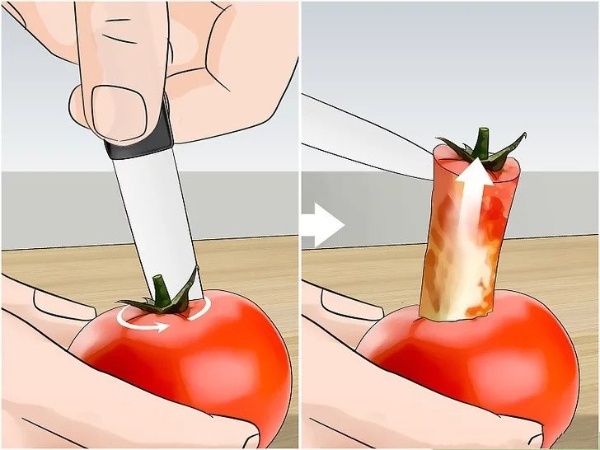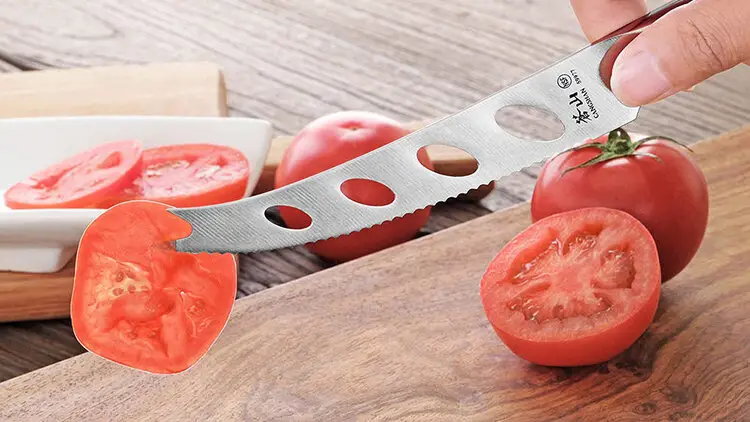Have you ever needed to prepare a crisp garden salad with freshly cut tomatoes? If you used the wrong knife, you likely ended up with a soggy mess (borderline salsa, even, depending on how badly you butchered your tomato).
A tomato knife is your catch-all solution. It features a specific design that allows you to cut your tomatoes seamlessly.
But the knife looks far from normal when you first use it. It has two points on the end, which intimidates some people before they use it.
Are you wondering, “why does a tomato knife have two points?”
A tomato knife has two points to make cutting easier. Use the two points to remove the tomato’s core and pick up slices on a cutting board without damaging the soft insides.
Below, we’ll provide a few more reasons why, explain a tomato knife’s structure and answer some FAQs.
Why Tomato Knives Have Two Points?
Reason #1: To Remove the Tomato Core
Not all parts of the tomato are ideal for every situation. You have the tomato’s core, stem, outer skin, and fleshy interior.
While some people eat the core and stem of the tomato slice, these components aren’t particularly delicious. They’re chewy and have an overall unpleasant texture.
A good chef will save these parts for unique dishes and adventurous eaters. For most meals, one of the best tips is to remove the tomato core before cutting the rest of it.
Luckily, a tomato knife with forked tip makes this task easy to perform, unlike a typical kitchen knife. It’s not too small nor too large, so you can perform a precise job without the risk of cutting yourself.

Here’s how to remove the tomato core:
- Set your vegetable down on your cutting board and look at it from directly above.
- Take your knife and run it around the vegetable’s core applying adequate pressure.
- Use the knife’s two points to move the core to the side.
Reason #2: To Lift and Move the Tomato Pieces
Picture this: you just cut through a whole cutting board’s worth of tomatoes. Now, you have to dig through your kitchen drawer to find a spoon to scoop them out of the way. Or, you have to pick up your cutting board and use your hand to push the tomatoes into a salad bowl. This transfer process can create quite a mess. This transfer process can create quite a mess.
Good news for you — a tomato knife comes with two points (forked tip) that let you transfer your freshly chopped pieces for cooking or other tasks easily.
There’s no need to stab your pieces and ruin their physical appearance. Use the two points to pick up and carry the pieces to wherever you need them, all without damaging them.
What Makes a Tomato Knife Stand Out?
After reading through this guide so far, you may be wondering, “what’s wrong with my trusty, all-purpose chef’s knife?”
Some cooks swear by an all-purpose knife, but this tool often isn’t enough to cut tomatoes. It may slice the vegetable, but it could damage the soft interior inside. And forget about moving the pieces from the cutting board to the place with the average knife.
Here are the two factors that make a tomato knife with serrations better than an all-purpose knife for cutting tomatoes.
Serrated Blade
Nothing about a tomato knife is smooth. Picture a shark’s jaw — it resembles a tomato knife’s serrated edge blade.
Straight-edge knives are ideal for mincing, dicing, slicing, and chopping hard or soft foods.
However, foods with soft interiors and hard exteriors require a serrated edge blade for optimal efficiency. They cut through foods with tough skin and efficiently run through the softer flesh components.
Because of the serrated blade’s design, you should always use a sawing motion while cutting tomato slices. This action will prevent unnecessary tears and keep your vegetables looking picture-perfect.
Two Points
When you picture a standard knife, you likely imagine a long blade with a single point.
A single point is functional, but it doesn’t offer the benefits that two points do.
When you look at a tomato knife, you’ll notice there are two points on its tip. One point sits directly below the other, creating a prong shape — picture Wolverine’s claw minus one point.
This unique shape allows for detailed cutting. You can use the blade to perform fine chops and create jaw-dropping platter presentations.
Frequently Asked Questions (FAQs)
If you’ve been using the same old knife to complete all of your slicing and dicing tasks in the kitchen for preparing different recipes, you may have a few unanswered questions left.
Below, we’ve answered some of the most commonly asked questions regarding the tomato knife and its cousin, the bread knife.
Why do bread knives have prongs?
Bread knives’ prongs allow the user to perform long, smooth strokes and pierce the bread’s outer surface without much effort, every time.
Can you use a bread knife to cut tomatoes?
A bread knife and tomato knife are very similar, as they both feature jagged lengths. You can easily use a bread knife to cut tomatoes.
What about straight-edged knives? These kitchen tools won’t be as effective as serrated ones for preparing your food. However, as long as you sharpen your straight-edged knife properly, you can perform a satisfactory job for the most part.
Do tomatoes blunt knives?
A common myth is that cutting tomatoes will dull your knives. Some people believe tomatoes’ acidity will cause their blades to become blunt. Others think that the sawing motion that serrated blades demand will cause bluntness.
These misconceptions couldn’t be further from the truth. As long as you take proper care of your blades, they shouldn’t blunt any quicker than usual.
Why does a tomato knife have holes in it?
Some tomato knives have holes in them because:
- Diminished friction: The holes let the blade avoid suction and move seamlessly through your tomatoes.
- Reduced weight: A tomato knife is pretty light, to begin with, but a couple of holes will reduce its weight even more. This lightweight design allows for precise, hassle-free use.
- Storage: Some manufacturers design the blades to have holes to allow for storage. You can use your blade’s holes to hang it on the wall for easy access.
What is a tomato knife used for?
First and foremost, chefs use this tool to cut tomatoes. However, they can also use it to perform cuts on other types of foods like:
- Cucumbers
- Lemons, limes, and other citrus fruit
- Bread
- Birthday cakes
- Phyllo dough
Should you cut tomatoes with a serrated knife?
We recommend cutting tomatoes with a serrated knife if you want to preserve the insides. If you try using a straight-edge knife, you may end up with gushy tomatoes.
Conclusion
We recommend getting a tomato knife if you’re sick of dealing with crushed tomatoes. This versatile tool features a unique two point design and serrated blade that helps you chop your tomatoes efficiently. It’s also applicable to other foods like bread, citrus fruits, and cucumbers.

